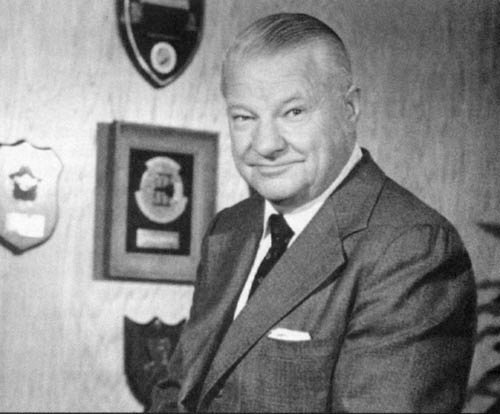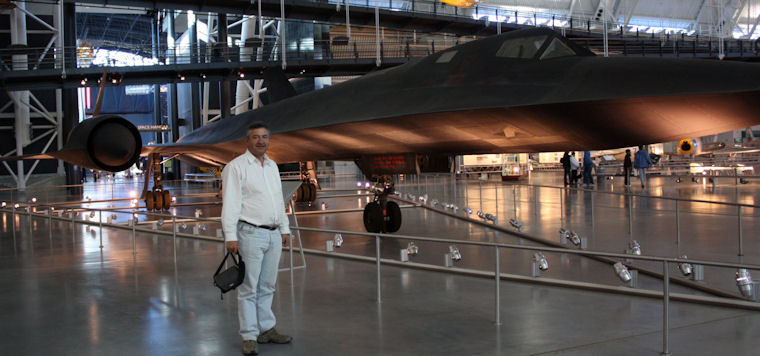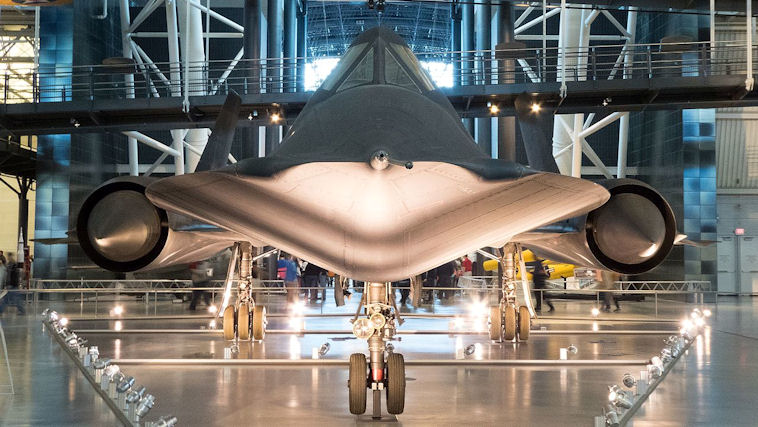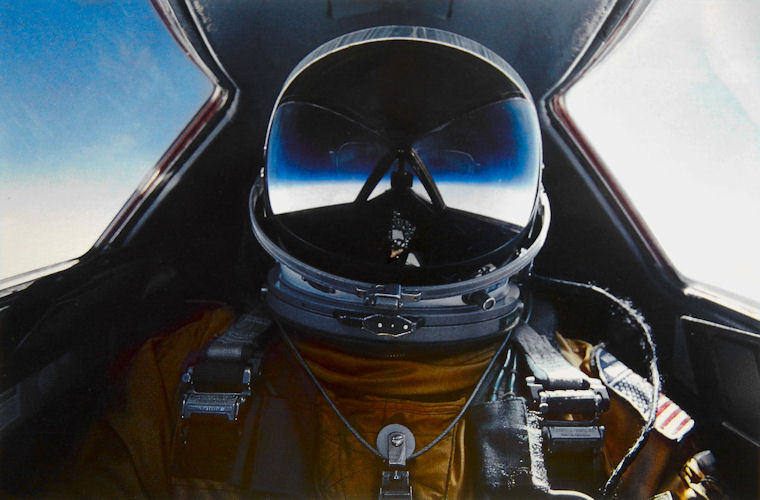






















Man's Greatest Inventions - The SR-71 Blackbird
By Juri Keyter
During my visit to the 2017 EAA Airventure in Oshkosh, I had the privilege to see the B1 Bomber and the B2 Bomber fly in formation over my head and that incredible experience made me think of man's greatest inventions. Of course, the next aircraft that came to mind in this elite category was the Lockheed Martin SR-71 Blackbird. Every aviation enthusiast in the 70s and 80s had an image of this piece of art either as a poster on the wall, a plastic model on a desk or even just an exhilarating thought (I had all three).

11 SR-71 Blackbirds parked together
Blackbird stories were aplenty and still is today but the most frequently shared story (certainly in the company I keep), is about various pilots requesting a speed check from a radar controller in LA. But let me not spoil it for you. Watch this video and get if from the SR-71 pilot Brian Shul himself.
The prelude to the SR-71 was the Lockheed U-2 reconnaissance aircraft which first flew in 1955 but when a U-2 flown by Gary Powers was disabled by a Soviet surface-to-air missile at 70,000 feet in 1960, the cold war was not that cold anymore and the need for an aircraft that could fly higher and faster than anything else became a necessity. Apart from speed, a decreased radar signature was another requirement and Lockheed's advanced development group, the Skunk Works®, responded to this seemingly impossible challenge.

Prelude to the SR-71, the Lockheed U-2 in formation with a SR-17
The mastermind behind both the U-2 and the SR-71 was Kelly Johnson. Johnson was not only a talented aeronautical engineer, he was a visionary and an artist. His ability to convert dreams into reality resulted in many of the design's innovative concepts and ultimately rendering the SR-71 one of man's greatest inventions.

Kelly Johnson
Although at the time, there were other aircraft capable of 2,000mph, but they could only achieve this for short periods of time with full after-burner. The speed requirement for the SR-71 was 2,000mph sustainable and this snowballed into more challenges such as friction and extreme temperatures exceeding 500 degrees Celsius at the leading edges. The answer was titanium. Yes, the same stuff used in your golf clubs or your watch but in those days, it was scarce and extremely difficult to work with. It is brittle and shatters if not handles correctly. Ironically, it was eventually imported through a ghost company in Europe from the Soviet Union.

SR-71 Manufacturing plant at Lockheed
With the leading edges exceeding 500 degrees Celsius and the ambient temperature outside the cockpit window at -50 degrees Celsius, this temperature differential led to structural deform and could even lead to electrical currents (Thermoelectric). Skunk Works' Ben Rich Knew that black paint both emits and absorbs heat and would therefore alleviate the problem by painting it black which led to the aircraft's common name: "Blackbird."

The original Blackbird was designated the A-12 and made its first flight on April 30, 1962. Breaking records nearly every time it flew, the Blackbird achieved a sustained speed above Mach 3 on July 20, 1963, at an astounding altitude of 78,000 feet. The single-seat A-12 soon evolved into the larger SR-71, which added a second seat for a Reconnaissance Systems Officer and carried more fuel than the A-12. The SR-71's first flight was on December 22, 1964.
A-12 First flight on 30 April 1962
SR-71 First flight on 22 December 1964
New records kept coming and the Blackbird is still the world's fastest and highest-flying manned aircraft. On its final flight in 1990 from Los Angeles to Washington where it is on display in the Smithsonian Air & Space collection, the plane flew coast to coast in 67 minutes.

The last SR-71 to fly. Now at the Smithsonian in Washington
Interesting features:
The SR-71 has a few distinct features such as the chine (the blended forward wing) extending from the front to the leading edge of the wing (approximately 40% of the aircraft length). The chine acts as a fixed canard to create substantial lift and stability.

The SR-71 Chine in full view
Its pair of Pratt & Whitney JT11D-20 (or J58) engines produced 32,500 pounds of thrust with full after burner and the distinctive sharp tip of the inlet spike was designed to slow the supersonic air before it enters the engine. The spike actually moves rearward as the aircraft increase speed preventing the engine from ingesting the supersonic shockwave to prevent engine flameout.

Operation of the air inlets and air flow patterns through the J58
The wing design is referred to as a biconvex delta wing with a sweep of 53 degrees. The wings also serve as fuel tanks but that is not the interesting fact. What is interesting is that the fuel seep through the wing seams while the Blackbird is parked on the ground leaving pools of fuel on the ground while when in flight, the friction and heat creates an almost 6 inch expansion tightening the seams which stops the leakage. The tyres are also inflated with aluminium powder and nitrogen to reflect and reduce airframe heat away from the tyres. Like any delta wing, there are no elevators or ailerons. Instead, it has 4 ailevons on the training edge of the wing to combine pitch and roll functions. The flashpoint of the JP-7 fuel used on the SR-17 is simply too high for normal ignition systems and the chemical triethylborane has to be injected with the fuel during start-up to ignite the fuel with a green flash coming out the exhaust. The heat of the wings during high speed flight will increase the temperature of Jet-A1 to a point where it would ignite inside the tanks.

Flying the Blackbird:
During take-off, the pilot use nose wheel steering up to a speed of 120kts and rotate at 215kts. Lift-off only happens at 230kts but with significant acceleration the pilot must immediately lift the gear before the Blackbird reaches 300kts. The initial climb rate is 10,000 fpm at 400kts.
The fuel loaded for take-off is reduced significantly as the aircraft cannot climb out of ground effect on a single engine at low speed and it is therefore a safety precaution in case of an engine failure. So once the Blackbird is airborne, the first task is mid-air refuelling and it takes approximately 3 minutes from brake release to meeting up with the tanker at 26,000 feet.

SR-71 refueling from a KC-135Q Stratotanker
The transition from subsonic to supersonic speeds happens at around 35,000 feet and incorporates a manoeuvre called "the dipsy doodle". In this manoeuvre, the pilot starts a descent of about 2,500fpm until Mach 1 is reached. At Mach 1.25 the pilot pitches up slight to resume the climb while maintaining or increasing the speed.
At Mach 3, a 30 degree bank will result in a turn rate of less than one third of a degree per second. To put this into perspective, a 180 degree turn takes 10 minutes with a turn diameter of about 200 miles (1 mile every 2 seconds). At this speed, everything must be in trim and a small periscope to check the rudder offset is available to the pilot.
The load limitations at Mach 3 is between -0.01G and 1.5G and although the SR-71 is pressurised, it remains a challenge at significantly high altitudes. At 75,000 feet as example, the cabin pressure will be equal to the air pressure at 25,000, not nearly good enough to survive without protection.

The SR-71 do not have any flaps or speed brakes and to fly this aircraft, you have to plan everything way in advance. The downwind speed is 250kts, final approach speed is 175kts and touchdown is at 155kts.
Interesting facts:
Total Built: 32
Lost in accidents: 12
Lost to enemy action: In 1981 Kelly Johnson announced that the SR-71 has had over 1,000 missiles launches against it, but none successful.
Estimated cost: $US34,000,000 per aircraft in 1964.
Max Gross Weight: 152,000 pounds with more than half being fuel.
Pilots qualified to fly the Blackbird: 125
Total mission flown: 3,551
Total flights: 17,300
Total Mach 3 flights: 11,675
Total Mach 3 hours: 2,752
Fuel burn: 44,000 pounds per hour
Information and photograph sources:
Lockheed Martin (www.lockheedmartin.com)
Wikipedia (www.wikipedia.org)

11 SR-71 Blackbirds parked together
Blackbird stories were aplenty and still is today but the most frequently shared story (certainly in the company I keep), is about various pilots requesting a speed check from a radar controller in LA. But let me not spoil it for you. Watch this video and get if from the SR-71 pilot Brian Shul himself.
The prelude to the SR-71 was the Lockheed U-2 reconnaissance aircraft which first flew in 1955 but when a U-2 flown by Gary Powers was disabled by a Soviet surface-to-air missile at 70,000 feet in 1960, the cold war was not that cold anymore and the need for an aircraft that could fly higher and faster than anything else became a necessity. Apart from speed, a decreased radar signature was another requirement and Lockheed's advanced development group, the Skunk Works®, responded to this seemingly impossible challenge.

Prelude to the SR-71, the Lockheed U-2 in formation with a SR-17
The mastermind behind both the U-2 and the SR-71 was Kelly Johnson. Johnson was not only a talented aeronautical engineer, he was a visionary and an artist. His ability to convert dreams into reality resulted in many of the design's innovative concepts and ultimately rendering the SR-71 one of man's greatest inventions.

Kelly Johnson
Although at the time, there were other aircraft capable of 2,000mph, but they could only achieve this for short periods of time with full after-burner. The speed requirement for the SR-71 was 2,000mph sustainable and this snowballed into more challenges such as friction and extreme temperatures exceeding 500 degrees Celsius at the leading edges. The answer was titanium. Yes, the same stuff used in your golf clubs or your watch but in those days, it was scarce and extremely difficult to work with. It is brittle and shatters if not handles correctly. Ironically, it was eventually imported through a ghost company in Europe from the Soviet Union.

SR-71 Manufacturing plant at Lockheed
With the leading edges exceeding 500 degrees Celsius and the ambient temperature outside the cockpit window at -50 degrees Celsius, this temperature differential led to structural deform and could even lead to electrical currents (Thermoelectric). Skunk Works' Ben Rich Knew that black paint both emits and absorbs heat and would therefore alleviate the problem by painting it black which led to the aircraft's common name: "Blackbird."

The original Blackbird was designated the A-12 and made its first flight on April 30, 1962. Breaking records nearly every time it flew, the Blackbird achieved a sustained speed above Mach 3 on July 20, 1963, at an astounding altitude of 78,000 feet. The single-seat A-12 soon evolved into the larger SR-71, which added a second seat for a Reconnaissance Systems Officer and carried more fuel than the A-12. The SR-71's first flight was on December 22, 1964.
A-12 First flight on 30 April 1962
SR-71 First flight on 22 December 1964
New records kept coming and the Blackbird is still the world's fastest and highest-flying manned aircraft. On its final flight in 1990 from Los Angeles to Washington where it is on display in the Smithsonian Air & Space collection, the plane flew coast to coast in 67 minutes.
The last SR-71 to fly. Now at the Smithsonian in Washington
Interesting features:
The SR-71 has a few distinct features such as the chine (the blended forward wing) extending from the front to the leading edge of the wing (approximately 40% of the aircraft length). The chine acts as a fixed canard to create substantial lift and stability.

The SR-71 Chine in full view
Its pair of Pratt & Whitney JT11D-20 (or J58) engines produced 32,500 pounds of thrust with full after burner and the distinctive sharp tip of the inlet spike was designed to slow the supersonic air before it enters the engine. The spike actually moves rearward as the aircraft increase speed preventing the engine from ingesting the supersonic shockwave to prevent engine flameout.

Operation of the air inlets and air flow patterns through the J58
The wing design is referred to as a biconvex delta wing with a sweep of 53 degrees. The wings also serve as fuel tanks but that is not the interesting fact. What is interesting is that the fuel seep through the wing seams while the Blackbird is parked on the ground leaving pools of fuel on the ground while when in flight, the friction and heat creates an almost 6 inch expansion tightening the seams which stops the leakage. The tyres are also inflated with aluminium powder and nitrogen to reflect and reduce airframe heat away from the tyres. Like any delta wing, there are no elevators or ailerons. Instead, it has 4 ailevons on the training edge of the wing to combine pitch and roll functions. The flashpoint of the JP-7 fuel used on the SR-17 is simply too high for normal ignition systems and the chemical triethylborane has to be injected with the fuel during start-up to ignite the fuel with a green flash coming out the exhaust. The heat of the wings during high speed flight will increase the temperature of Jet-A1 to a point where it would ignite inside the tanks.

Flying the Blackbird:
During take-off, the pilot use nose wheel steering up to a speed of 120kts and rotate at 215kts. Lift-off only happens at 230kts but with significant acceleration the pilot must immediately lift the gear before the Blackbird reaches 300kts. The initial climb rate is 10,000 fpm at 400kts.
The fuel loaded for take-off is reduced significantly as the aircraft cannot climb out of ground effect on a single engine at low speed and it is therefore a safety precaution in case of an engine failure. So once the Blackbird is airborne, the first task is mid-air refuelling and it takes approximately 3 minutes from brake release to meeting up with the tanker at 26,000 feet.

SR-71 refueling from a KC-135Q Stratotanker
The transition from subsonic to supersonic speeds happens at around 35,000 feet and incorporates a manoeuvre called "the dipsy doodle". In this manoeuvre, the pilot starts a descent of about 2,500fpm until Mach 1 is reached. At Mach 1.25 the pilot pitches up slight to resume the climb while maintaining or increasing the speed.
At Mach 3, a 30 degree bank will result in a turn rate of less than one third of a degree per second. To put this into perspective, a 180 degree turn takes 10 minutes with a turn diameter of about 200 miles (1 mile every 2 seconds). At this speed, everything must be in trim and a small periscope to check the rudder offset is available to the pilot.
The load limitations at Mach 3 is between -0.01G and 1.5G and although the SR-71 is pressurised, it remains a challenge at significantly high altitudes. At 75,000 feet as example, the cabin pressure will be equal to the air pressure at 25,000, not nearly good enough to survive without protection.

The SR-71 do not have any flaps or speed brakes and to fly this aircraft, you have to plan everything way in advance. The downwind speed is 250kts, final approach speed is 175kts and touchdown is at 155kts.
Interesting facts:
Total Built: 32
Lost in accidents: 12
Lost to enemy action: In 1981 Kelly Johnson announced that the SR-71 has had over 1,000 missiles launches against it, but none successful.
Estimated cost: $US34,000,000 per aircraft in 1964.
Max Gross Weight: 152,000 pounds with more than half being fuel.
Pilots qualified to fly the Blackbird: 125
Total mission flown: 3,551
Total flights: 17,300
Total Mach 3 flights: 11,675
Total Mach 3 hours: 2,752
Fuel burn: 44,000 pounds per hour
Information and photograph sources:
Lockheed Martin (www.lockheedmartin.com)
Wikipedia (www.wikipedia.org)
 |
 |
 Copyright © 2024 Pilot's Post PTY Ltd
The information, views and opinions by the authors contributing to Pilot’s Post are not necessarily those of the editor or other writers at Pilot’s Post.
Copyright © 2024 Pilot's Post PTY Ltd
The information, views and opinions by the authors contributing to Pilot’s Post are not necessarily those of the editor or other writers at Pilot’s Post.